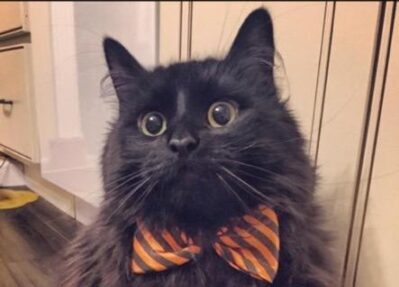Originally published in the October 28, 2022, edition of the Valley Advantage
The air is getting cooler and the leaves are starting to change in the northeastern United States. This can only mean one thing — Halloween is right around the corner and crossing its path is the iconic black cat!
According to folklore and cultural traditions, this can lead to a variety of different beliefs ranging from bad luck to prosperity, but ultimately, “A black cat crossing your path signifies that the animal is going somewhere,” as Groucho Marx said.
To begin, let’s explore some age-old legends and lore that surround these black beauties. It is believed that superstitions started sometime around the Middle Ages.
During this time in Western Europe, black cats were perceived as signs of evil, disease, death and overall misfortune. Years later, these strong negative assumptions followed the felines to the new world with the Pilgrims, regardless of positive cultural beliefs in places such as the UK.
People became wary of the suspicions tied to black cats. Those who were most frightened of them killed the creatures for fear that they themselves could be accused of witchcraft. Severe punishments and even death could be brought upon those who were associated with the earth-roaming beasts that were also considered part demons.
On the other side of their unfortunate history, black cats were perceived as good luck, or even divine, in Japanese, English, Scottish, French, Egyptian and Latvian cultures. According to French folklore, plucking one white hair from a black cat without getting scratched foretells good luck in times to come! Of course, we do not promote this silly practice!
According to some shelter and rescue organizations, myths of misfortune may still follow black cats — along with black animals as a whole. This phenomenon is known as Black Dog/Cat Bias or Black Dog Syndrome. BDS is a theory that black dogs and cats have lesser odds of being adopted in a timely manner, which then puts them at higher risk for euthanasia in comparison to their colorful counterparts.
Some characteristics that may contribute to this theory are due to dark coat color and include hard-to-see facial expressions, tricky observation in dimly lit kennels and difficulty to photograph when trying to promote these animals online. Other factors include negative portrayals of black animals in popular media such as movies/books and, of course, lingering superstition. Although research has shown conflicting results over the years as to if this phenomenon is real, it is determined that plenty of black cats and dogs are available for adoption across the United States, seeking a bright future in a loving home!
Although there is a common myth that shelters will not adopt black cats around Halloween due to fear of ritual sacrifice, this is considered to be a rumor. In some shelters, they use this holiday as an opportunity to show off these felines’ beautiful ebony fur as a promotional point to help get these animals adopted!
Although ritual sacrifice may be a rumor, there may be a more probable concern about irresponsible adopters using these animals as holiday props, much like the well-known bunny adoptions for Easter. On the other hand, genuine prospective adopters may be on the look out for black cats in the shelter because they have heard of these urban legends and want to help!
So, what can we do to rid these negative myths crossing the black cat’s path for hundreds of years? Fortunately, there are a few options!
Check if your local shelter participates in celebrations such as “International Black Cat Awareness Month” in October or “Friday the 13th” adoption events. Some benefits may include a reduced adoption price!
Be sure to educate family, friends, and young children to help stop the bias in its tracks. Lastly, if you are currently an owner of a black cat, boast about your “house panther” to show there is nothing to fear, and personality should come first when choosing the perfect (dare I say … purrfect?) feline companion!
Amanda Melnyk, AS, CVT, ’09, is a full time CVT instructor at the Johnson College’s Veterinary Nursing program as well as a clinical rotation instructor at the Animal Care Center on campus. She has been a part of the veterinary field for 14 years.

